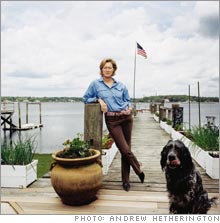Have a growth mind-set Lesson 2: Failing at something is the best way to ensure success at it the next time.
NEW YORK (Money Magazine) -- "I don't know if you've ever seen a mill hole," said Arthur Tauck in a voice so deep and gravelly it seemed to come from somewhere under the floor. Tauck, 74, is the chairman of Tauck World Discovery, a travel company his father founded in 1925, and he was explaining a lucrative niche he himself had invented three decades ago. In front of his home, a glistening sandbar sprawled between his seawall and the waters of Long Island Sound. I told him I had never seen a mill hole, and he frowned.
"A mill hole is a hole in a glacier formed by water on the surface," he said. "It can go down 300 feet, and the water running down it looks like when you flush a toilet and see the water spinning around. You throw a rock down a mill hole and you think it's gone, but then after a long minute you hear it hit the bottom. Well, we would take people in their seventies and put a rope around their waist so they could crawl right up to the edge, on their stomach, and look down in the mill hole." One summer Tauck was helicopter-skiing in the Cariboo Mountains of western Canada when he wondered if anyone used the helicopters and remote mountain lodges during the summer. Turned out, they just sat there. So Tauck partnered with locals to crank up the helicopters and open the lodges, sharing the costs of marketing and staffing. Within months his company began offering tours for elderly people to places they never could have seen without a company like his: glaciers, mountaintops and mill holes. The trips were booked solid for years, and they inspired Tauck to dream up other off-the-beaten-track itineraries. (From his time in the Air Force, he recalled that European road maps had yellow lines indicating less traveled roads, and today the Yellow Roads of Europe trips are among Tauck's most popular.) His company now offers more than 100 different trips to tens of thousands of travelers each year. When he took over the business, there were 1,200 clients and six trips, none involving yellow roads or mill holes. Lots of people in the travel business had likely seen those lodges and helicopters, but it took an open mind to come up with the idea of heli-hiking. "I had a vision that people would buy something that was not yet discovered. That was a risk," he said. "Is the 75-year-old spirit still wanting to feel 25 years old? I thought so." Carol Dweck, a psychologist and professor at Stanford University, studies the connections between people's outlook and their willingness to take risks. "The view you adopt for yourself profoundly affects the way you lead your life," she writes in her book "Mindset," which was published earlier this year. Dweck identifies two types of people: those who have fixed mind-sets and those who have growth mind-sets. People with fixed mind-sets believe that they were born with a certain amount of intelligence, and they strive to convince the world of their brilliance so that no one finds out they're not actually geniuses. Growth-mind-set people believe that intelligence, knowledge and skill need to be "cultivated" by trial and error. Failing at something, they believe, is the best way to ensure they'll succeed at it the next time. Carole Reichhelm: Looking nearby where everybody else is looking Carole Reichhelm, the woman I met on the first day of door knocking, lives down the street from Tauck and has a similar knack for identifying something people covet - waterfront property, in her case. Westport, a particularly affluent bedroom community on Long Island Sound about 50 miles from Manhattan, is the perfect town for Reichhelm, who has an addiction to beachfront herself. All the waterfront acreage in town was bought up long ago, so Reichhelm looks for it when she travels - especially when she's in a place that hasn't gotten hot yet. "God made only so much waterfront," she said, waving an arm at the brackish waters of Saugatuck Bay outside. "It's not like He's making any more." (Unless that's what this whole global warming thing is about.) She and her husband George bought their 1/10-acre lot in 1983 for $260,000, tore down the A-frame that stood there and built a house. Today, George raises oysters on a little beach out front. "We wouldn't take $2.5 million for this place," she said. Think all the good, affordable waterfront property in the world is gone? Reichhelm doesn't. She says the trick is not to look where everyone else is looking but to look nearby. Like the best stock investors, she gets in for cheap on lots that aren't overvalued. That way she can scoop up more property for less money, and if a couple of investments flop, the one that doesn't makes up for the rest. Mexico is popular, but not lower Baja, where 100-foot waterfront tracts are selling for $500,000 or less. (She just snagged two.) While the eyes of many speculators have been trained on Gulf Coast deals for months now, Reichhelm looked nearby, snapping up 3.5 acres on the Cossatot River in Arkansas (Arkansas!) for $120,000 while on a road trip. As she put it, "I'm just always looking for the last best place." _________________________________ Lesson 1: Make your own luck...Beverly Hills, Calif. 90210 Lesson 1, Corollary 1: Make others lucky too...Paradise Valley, Ariz. 85253 Lesson 2: Have a growth mind-set...Westport, Conn. 06880 Lesson 2, Corollary 1: Never stop learning...Atherton, Calif. 94027 Lesson 2, Corollary 2: Calculate your risk...Lake Forest, Ill. 60045 |
| ||||||||||||

